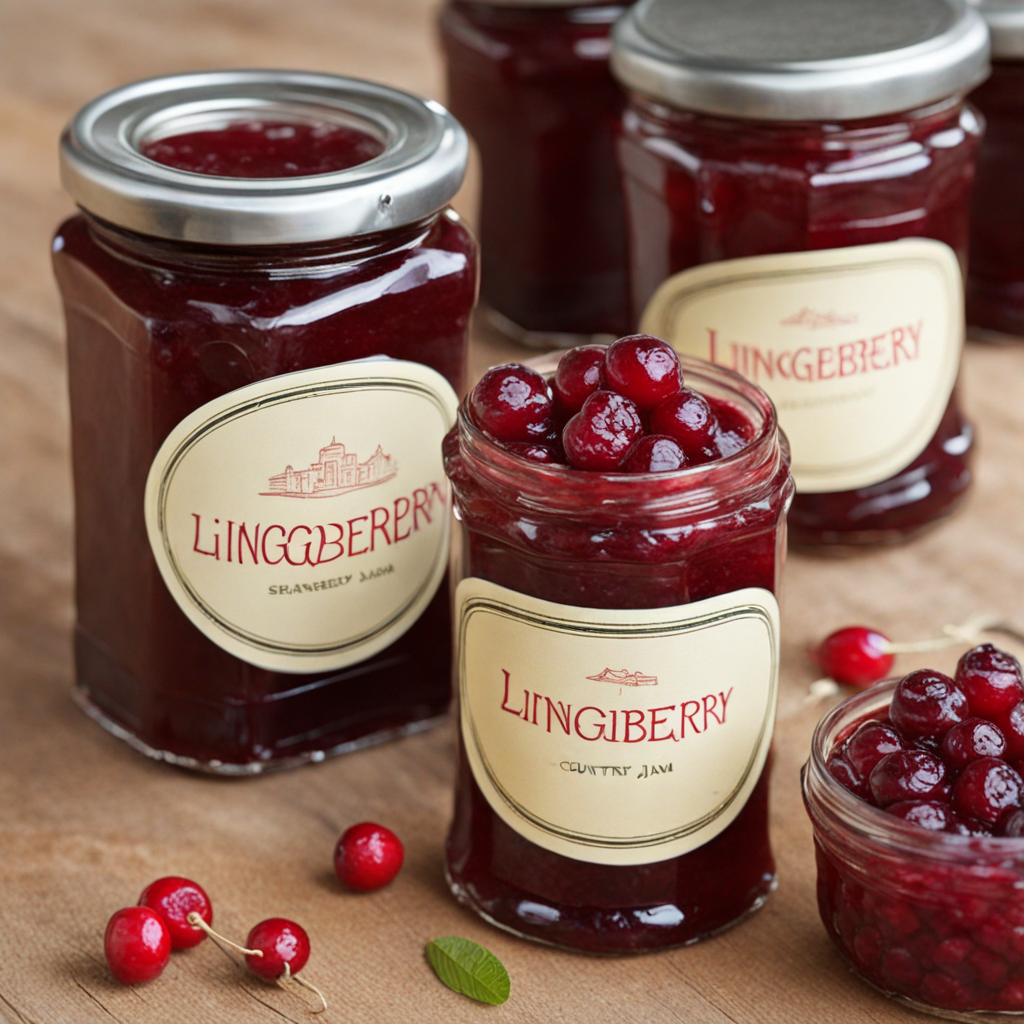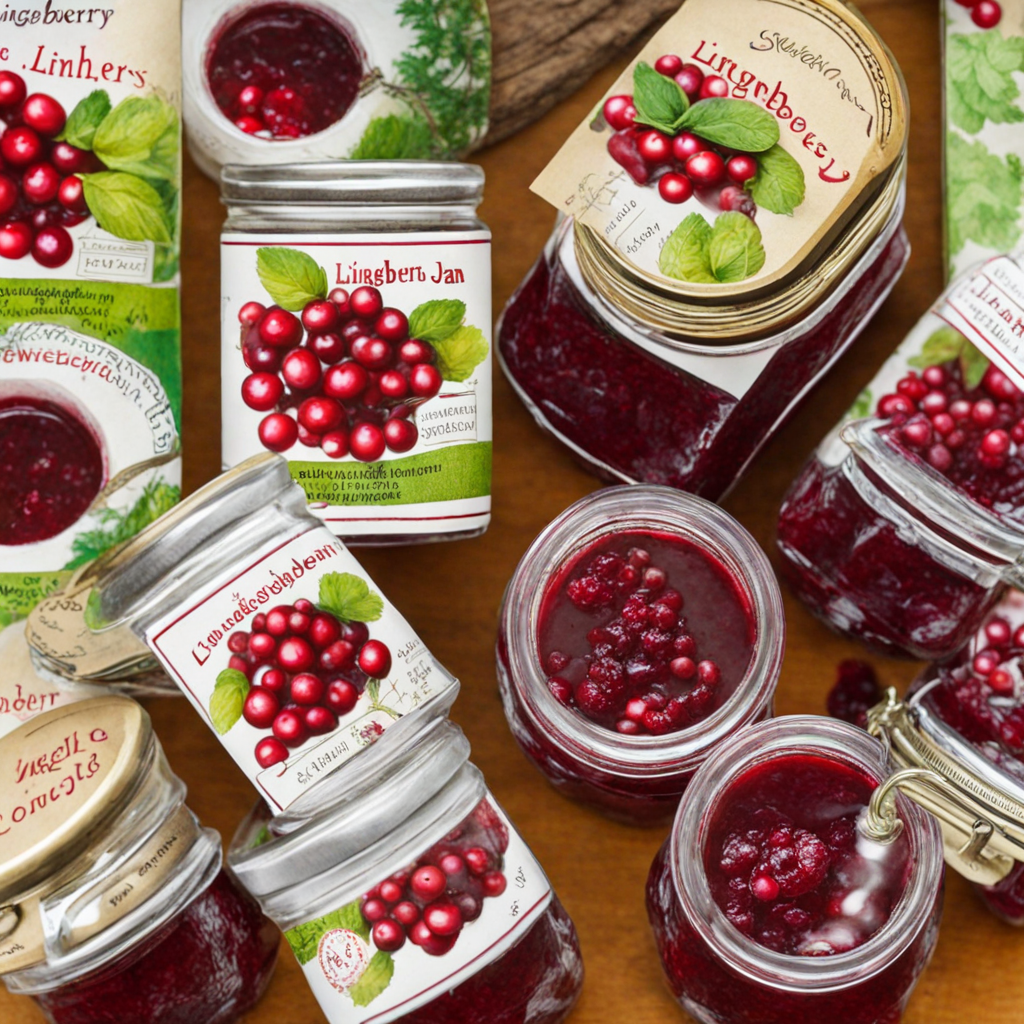Lingonberry Jam
Lingonberry Jam is a vibrant and tart spread hailing from the picturesque landscapes of Sweden. Made from the small, red lingonberries, which grow wild in the forests, this jam captures the essence of Nordic nature. The berries are typically harvested in late summer to early autumn, and their bright, tangy flavor is beautifully balanced by a touch of sweetness, often achieved by adding sugar and sometimes a hint of lemon juice. The result is a rich, ruby-red jam that not only delights the palate but also offers a stunning visual appeal when served. The taste of Lingonberry Jam is a delightful mix of sweet and sour, with a pronounced acidity that can awaken the senses. This unique flavor profile makes it an excellent companion to a variety of dishes. In Sweden, it is traditionally served alongside savory foods such as meatballs, game meats, and roasted dishes, enhancing the flavors with its fruity brightness. The jam can also be paired with breakfast items like pancakes, porridge, or even spread on toast for a refreshing start to the day. Beyond its culinary uses, Lingonberry Jam is also celebrated for its health benefits. Lingonberries are rich in antioxidants and vitamins, contributing to their popularity in Swedish cuisine. Whether enjoyed as a condiment, a sweet addition to desserts, or a simple spread, this jam invites food lovers to explore a new layer of flavor that is both distinctly Swedish and universally appealing. The experience of tasting Lingonberry Jam is not just about savoring a new flavor; it's about connecting with the rich traditions and natural bounty of Sweden.
How It Became This Dish
The History of Lingonsylt: A Taste of Sweden #### Origins and Early Beginnings Lingonsylt, or lingonberry jam, is a quintessential Swedish condiment that has become synonymous with Scandinavian cuisine. The lingonberry (Vaccinium vitis-idaea) is a small, bright red berry that grows wild in the forests of Sweden and across other Nordic countries. Its tart flavor and vibrant color make it a perfect candidate for preservation, and the tradition of turning these berries into jam has deep roots in Swedish history. The lingonberry itself has been a part of the Swedish landscape for centuries, and it is believed that the indigenous Sámi people were among the first to forage these berries for their nutritional value. Lingonberries thrive in acidic, sandy soil and are often found in coniferous forests, making them readily available to those living in rural areas. As agriculture in Sweden began to develop in the early Middle Ages, the gathering of wild berries, including lingonberries, became a significant aspect of food culture and sustenance. #### Cultural Significance Lingonsylt is more than just a delicious spread; it is an emblem of Swedish heritage and identity. The practice of making lingonberry jam can be traced back to the pre-industrial era when preservation was essential for survival during the harsh Nordic winters. The tartness of the lingonberry makes it an ideal complement to many traditional Swedish dishes, particularly meat-based meals. For instance, it is often served alongside meatballs (köttbullar), cured salmon (gravlax), and various game meats, enhancing the flavors of these hearty dishes with its bright acidity. In Swedish homes, lingonsylt is a staple found on dining tables year-round, reflecting both the cultural significance of the berry and the importance of seasonal eating. The act of foraging for lingonberries, often a communal activity, fosters a connection to nature and evokes feelings of nostalgia and tradition. Many families have their own secret recipes and methods for preparing lingonsylt, passed down through generations, imbuing the jam with personal and familial meaning. #### The Evolution of Lingonsylt As Sweden progressed through the ages, so too did the methods for preparing lingonsylt. In the late 19th century, the rise of industrialization and urbanization led to changes in food production and preservation techniques. With the advent of canning and the introduction of sugar as a preservative, the process of making lingonsylt became more standardized. Sugar not only helped prolong the shelf life of the jam but also balanced the natural tartness of the lingonberry, creating a more palatable product for a growing urban population. During this period, lingonsylt began to feature more prominently in Swedish cookbooks and culinary literature. The 19th century was a time of national romanticism in Sweden, where there was a renewed interest in traditional Swedish foods, and lingonberry jam became a symbol of national identity. It was embraced not only as a food item but also as a representation of the Swedish landscape and way of life. Cookbooks began to include recipes for lingonsylt, often highlighting its versatility and the joy of making it from scratch. #### Lingonsylt in the 20th Century The 20th century saw further developments in the production and consumption of lingonsylt. After World War II, Sweden experienced a surge in consumerism, and ready-made products became increasingly popular. While many families still prepared homemade lingonsylt, commercial brands began to emerge, providing convenient alternatives. These products, often found in grocery stores, made lingonsylt accessible to a broader audience, ensuring that this traditional condiment remained a staple in Swedish kitchens, even for those who lacked the time or knowledge to make it themselves. Moreover, the global interest in Swedish cuisine began to rise during the late 20th century, particularly with the global expansion of Swedish furniture giant IKEA. The company's Swedish meatballs served with lingonsylt became a culinary phenomenon, introducing international audiences to this unique flavor combination. As Swedish cuisine gained popularity, lingonsylt became a symbol not just of Swedish food culture but also of the broader Scandinavian culinary movement, which emphasized simplicity, freshness, and the use of high-quality, local ingredients. #### Contemporary Lingonsylt Today, lingonsylt is celebrated both in Sweden and abroad. The jam is not only a staple in Swedish households but has also found its way into the hearts and kitchens of food lovers around the world. While traditional recipes still prevail, contemporary interpretations of lingonsylt have emerged, incorporating various spices, such as cinnamon and cardamom, to create unique flavor profiles. In Sweden, lingonsylt is often served during festive occasions, particularly during the Christmas season, where it accompanies julskinka (Christmas ham) and other traditional dishes. It is also a popular topping for pancakes and porridge, making it a versatile addition to both savory and sweet meals. As sustainability and local food movements gain traction globally, the practice of foraging for lingonberries has seen a revival, with many Swedes taking to the forests to pick these delicious berries once again, ensuring that the tradition lives on. #### Lingonsylt in the Global Context As the world becomes increasingly interconnected, lingonsylt has found its place in the global culinary landscape. Swedish restaurants and Scandinavian food markets abroad often feature lingonberry products, catering to a growing interest in Nordic cuisine. Chefs and home cooks alike have begun experimenting with lingonberries in various dishes, using them in sauces, desserts, and even cocktails, showcasing their versatility and unique flavor. The rise of social media has also played a role in popularizing lingonsylt, with food bloggers and influencers sharing recipes and stories that celebrate this traditional jam. Its bright color and vibrant presentation make it an attractive ingredient for food photography, further enhancing its appeal. #### Conclusion Lingonsylt is much more than a mere condiment; it is a reflection of Swedish culture, history, and identity. From its origins as a foraged berry to its place on modern dining tables, lingonberry jam tells a story of connection to the land, a celebration of tradition, and a testament to the enduring power of food in shaping cultural identity. As Sweden continues to evolve, so too does the legacy of lingonsylt, ensuring that this beloved jam will remain a cherished part of Swedish cuisine for generations to come.
You may like
Discover local flavors from Sweden







